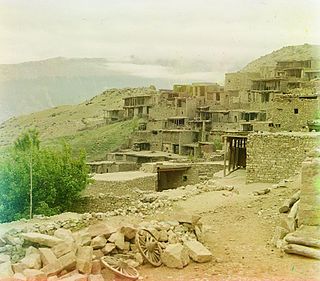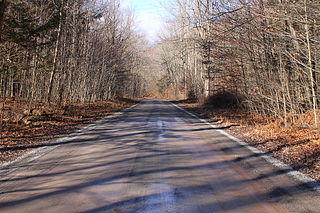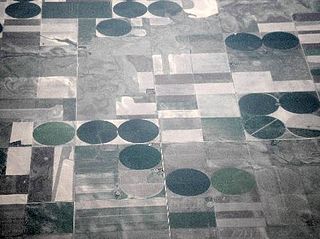 W
WAn Angerdorf is a type of village that is characterised by the houses and farmsteads being laid out around a central grassed area, the anger, a village green which was common land, owned jointly by the village community. The anger is usually in the shape of a lens or an eye, but may also take other forms: a rectangle, triangle, circle or semi-circle (illustrated). The buildings are oriented with their eaves facing the road. Livestock stalls and barns are at the rear of the plot and may be linked by a farm track that runs around the village forming an outer ring.
 W
WAn aul is a type of fortified village found throughout the Caucasus mountains and Central Asia.
 W
WThe boondocks is an American expression from the Tagalog word bundók ("mountain"). It originally referred to a remote rural area, but now, is often applied to an out-of-the-way area considered backward and unsophisticated by city-folk. It can also refer to a mountain.
 W
WA börde is a region of highly fertile lowland in North Germany, a "fertile plain". These landscapes often cover great areas and are particularly important for arable farming on account of their rich soils.
 W
W"The bush" is a term mostly used in the English vernacular of Australia and New Zealand where it is largely synonymous with backwoods or hinterland, referring to a natural undeveloped area. The fauna and flora contained within this area must be indigenous to the region, although exotic species will often also be present.
 W
WA commuter town is a populated area that is primarily residential, rather than commercial or industrial. People who live in commuter towns usually work in other places. Routine travel from home to work and then from work to home is called commuting, which is where the term comes from.
 W
WThe Country and the City is a book of cultural analysis by Raymond Williams which was first published in 1973.
 W
WDhani or Thok is a type of hamlet, the smallest conglomeration of houses, in sandy Bagar region of northwestern states of Rajasthan, Haryana and Punjab in India. Per Census of India, 70% of Indians live in villages. 80% of the villages have a population of less than 1000 people and each consists of a cluster of hamlets. Most dhanis are nucleated settlements, while others are more dispersed. A dhani could be as small as one isolated house for a single family or a small cluster of several houses which could grow in number with successive generations, and even become a village by itself. All families living in a dhani are relatives or at least are of the same caste. An isolated collection of several of dhanis, which could be few hundred meters apart, constitutes a gram panchayat village community. A typical dhani in the arid zone of Rajasthan is a cluster of huts with a boundary made of dried shrubs around it and with owners' livestock such as goats, sheep and camels inside the bara. Dhani are atypically mud huts in Rajasthan. Houses in dani nowadays are made of modern brick and mortar, specially in affluent higher-per-capita-income states of Haryana and Punjab, and some richer families of Rajasthan.
 W
WAn exurb is an area outside the typically denser inner suburban area of a metropolitan area, which has an economic and commuting connection to the metro area, low housing density, and growth. It shapes an interface between urban and rural landscapes holding an urban nature for its functional, economic, and social interaction with the urban center, due to its dominant residential character. The word exurb was coined by Auguste Comte Spectorsky, in his 1955 book The Exurbanites, to describe the ring of prosperous communities beyond the suburbs that are commuter towns for an urban area.
 W
WFallow is a farming technique in which arable land is left without sowing for one or more vegetative cycles. The goal of fallowing is to allow the land to recover and store organic matter while retaining moisture and disrupting the lifecycles of pathogens by temporarily removing their hosts.
 W
WA farm is an area of land that is devoted primarily to agricultural processes with the primary objective of producing food and other crops; it is the basic facility in food production. The name is used for specialised units such as arable farms, vegetable farms, fruit farms, dairy, pig and poultry farms, and land used for the production of natural fibres, biofuel and other commodities. It includes ranches, feedlots, orchards, plantations and estates, smallholdings and hobby farms, and includes the farmhouse and agricultural buildings as well as the land. In modern times the term has been extended so as to include such industrial operations as wind farms and fish farms, both of which can operate on land or sea.
 W
WA Haufendorf is an enclosed village with irregular plots of land and farms of greatly differing scale, usually surrounded by a stockade fence. They are typically found in Germany, Austria and Switzerland, whence the name. Haufendörfer (pl.) differ from most other types of village in that they are irregularly laid out. A large number of Haufendörfer emerged in connexion with the medieval open field system (Gewanneflur), where each farmer farmed strips of different fields and the location of these field strips continually changed. The district (Gemarkung) was divided into the village core (Dorfkern), field system (Ackerflur) and common pasture (Allmende).
 W
WA khutor or khutir is a type of rural locality in some countries of Eastern Europe; in the past the term mostly referred to a single-homestead settlement. The term can be translated as "hamlet".
 W
WKishlak or qishlaq, or qıştaq qıstaw is a rural settlement of semi-nomadic Turkic peoples of Central Asia and Azerbaijan. The meaning of the term is "wintering place" in Turkic languages.
 W
WThe Outback is the vast remote interior of Australia. The Outback is more remote than the bush, which includes any location outside the main urban areas.
 W
WPogost is a historical term with several meanings in the Russian language. It has also been borrowed into Latgalian (pogosts), Finnish (pogosta) and Latvian (pagasts), with specific meanings.
 W
WA Rundling is a form of circular village, mainly in Germany, typical of settlements in the Germanic-Slav contact zone in the Early Medieval period.
 W
WIn general, a rural area or countryside is a geographic area that is located outside towns and cities. The Health Resources and Services Administration of the U.S. Department of Health and Human Services defines the word rural as encompassing "...all population, housing, and territory not included within an urban area. Whatever is not urban is considered rural."
 W
WApproximately 97% of United States' land area is within rural counties, and 60 million people reside in these areas.
 W
WThe definition of a rural settlement depends on the country. In some countries, a rural settlement is any settlement in the areas defined as rural by a governmental office, e.g., by the national census bureau. This may include even rural towns. In some others, rural settlements traditionally do not include towns.
 W
WStanitsa is a village inside a Cossack host (viysko). Stanitsas were the primary unit of Cossack hosts. Stanitsas were Cossack military settlements.
 W
WA sunken lane is a road or track that is significantly lower than the land on either side, not formed by the (recent) engineering of a road cutting but possibly of much greater age.
 W
WA village is a clustered human settlement or community, larger than a hamlet but smaller than a town, with a population typically ranging from a few hundred to a few thousand. Though villages are often located in rural areas, the term urban village is also applied to certain urban neighborhoods. Villages are normally permanent, with fixed dwellings; however, transient villages can occur. Further, the dwellings of a village are fairly close to one another, not scattered broadly over the landscape, as a dispersed settlement.
 W
WThe Waldhufendorf is a form of rural settlement established in areas of forest clearing with the farms arranged in a series along a road or stream, like beads on a chain. It is typical of the forests of central Germany and is a type of Reihendorf, in which each farmstead usually has two wide strips of land adjacent to the farmhouse.
 W
WThe Zeilendorf is one of the historical types of village that emerged in Central Europe and consists of a single row of houses or farmsteads arranged in a regular and linear fashion. Zeilendörfer tend to occur as a result of the terrain and often lie on the edge of broad valleys. The individual house plots are arranged along a village street and have strips of farmland adjacent to the dwelling. It is a type of linear village.